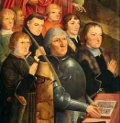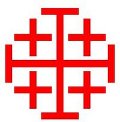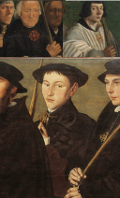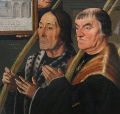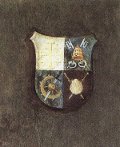Attributes and insignia
Most of the portraits included here show attributes which indicate that the portrayed person was a Jerusalem pilgrim. In many cases, these attributes are even the only evidence we have to indentify someone as a Jerusalem pilgrim, for instance in the case with the memorial panel of the Boelen family.
Palm branch
Palm branches, or 'feathers of Jericho', were carried by the members of the Jerusalem confraternities during Palm Processions. They are therefore prominently displayed on the confraternity portraits, which also remind us of the procession by their composition. On other kinds of portraits and memorial objects, pilgrims are often recognizable by their palm branches as well. The palm branch as an attribute is only known from areas where confraternities existed. This implies that the use of the palm branch as an attribute was closely connected to the confraternities. It does not mean, however, that the inclusion of a palm branch in a portrait automatically meant that the sitter was a member of a confraternity of Jerusalem pilgrims.
Jerusalem cross
This is a Greek cross with small crosses displayed in each of the four corners. It is displayed in various forms: worn as a gold pendant necklace, embroidered on clothing, on coats of arms, or elsewhere on an object. From documentary sources it is moreover known that a golden Jerusalem cross on a chain was handed to a person after he was knighted in the Order of the Holy Sepulchre.1 In the confraternity portraits a striking difference can be seen between crosses worn on clothing and those worn as golden pendants. It is therefore tempting to see this as a distinction between knights of the Holy Sepulchre and 'ordinary' pilgrims. Too little is known about the background of many persons to be sure about this distinction, though, and the attribute is not always used consistently. Dirk van Zwieten, for example, is called ridder ten Heylighen Graeve
(Knight of the Holy Sepulchre), but he does not carry a golden cross. Moreover, it is striking that many gold pendants are simply Greek crosses rather than Jerusalem crosses in the strict sense. They are used interchangeably with Jerusalem crosses, though, and were probably also viewed as equal, as we can see with Jan van Ede, who is called 'ritter' (knight, i.e. of the Holy Sepulchre) indeed.
The red Jerusalem cross on a silver shield was the coat of arms of the Franciscans in the Holy Land, and of the Jerusalem confraternities. It is therefore displayed sometimes. In South Eastern Germany, on the other hand, a red Jerusalem cross seems to exclusively identify a knight of the Holy Sepulchre, as can be seen in the portraits of the Ketzel family, where the red cross is included among all kinds of other knightly signs.
Wheel and sword of St Catherine
This symbol indicates a pilgrimage to the monastery of St Catherine in the Sinai. There one could be knighted as well, but the connection with the symbol is here even more unclear than with the gold Jerusalem cross. Moreover, a half wheel is often displayed, which indicates that the pilgrim probably did not go to the monastery. After all, at a certain moment one could also be knighted in the order of St Catherine elsewhere (Bethlehem, Cyprus), because of the difficult accessibility of the Sinai peninsula.2
Other attributes
A (necklace with a) sword and a ribbon signifies a Knight of Cyprus, to be seen among others in the Ketzel family and with two members of the Haarlem Confraternity of Jerusalem pilgrims. Signs of other pilgrimages are common as well, for example on the portrait of Wouter van Middengael, but mainly on tomb slabs. Scallops of St James, for example, indicate a pilgrimage to Santiago, and two crossed keys usually indicate a pilgrimage to Rome.
Previous: Function: Portraits as memoria?
Next: A Dutch phenomenon?
- Schneider, Wolfgang, Peregrinatio Hierosolymitana. Studien zum spätmittelalterlichen Jerusalembrauchtum und zu den aus der Heiliglandfahrt hervorgegangenen nordwesteuropäischen Jerusalembruderschaften (Münster 1982), p. 209.
- Ibid., p. 219.
